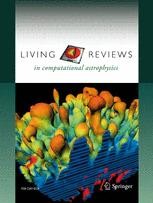LRCA: Higher-order accurate space-time schemes for computational astrophysics
 Balsara, D.S., Higher-order accurate space-time schemes for computational astrophysics—Part I: finite volume methods, Living Rev Comput Astrophys (2017) 3: 2. https://doi.org/10.1007/s41115-017-0002-8
Balsara, D.S., Higher-order accurate space-time schemes for computational astrophysics—Part I: finite volume methods, Living Rev Comput Astrophys (2017) 3: 2. https://doi.org/10.1007/s41115-017-0002-8
Review Article | Open Access
Published: 11 December 2017
Abstract:
As computational astrophysics comes under pressure to become a precision science, there is an increasing need to move to high accuracy schemes for computational astrophysics. The algorithmic needs of computational astrophysics are indeed very special. The methods need to be robust and preserve the positivity of density and pressure. Relativistic flows should remain sub-luminal. These requirements place additional pressures on a computational astrophysics code, which are usually not felt by a traditional fluid dynamics code. Hence the need for a specialized review. The focus here is on weighted essentially non-oscillatory (WENO) schemes, discontinuous Galerkin (DG) schemes and PNPM schemes. WENO schemes are higher order extensions of traditional second order finite volume schemes. At third order, they are most similar to piecewise parabolic method schemes, which are also included. DG schemes evolve all the moments of the solution, with the result that they are more accurate than WENO schemes. PNPM schemes occupy a compromise position between WENO and DG schemes. They evolve an Nth order spatial polynomial, while reconstructing higher order terms up to Mth order. As a result, the timestep can be larger. Time-dependent astrophysical codes need to be accurate in space and time with the result that the spatial and temporal accuracies must be matched. This is realized with the help of strong stability preserving Runge–Kutta schemes and ADER (Arbitrary DERivative in space and time) schemes, both of which are also described. The emphasis of this review is on computer-implementable ideas, not necessarily on the underlying theory.
